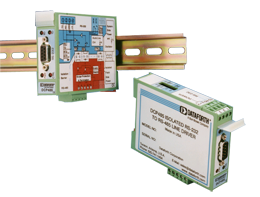SCM9B-A1000-230
RS-232C/RS-485 Converter/Repeater, 230VAC

SCM9B-A1000-230
RS-232C/RS-485 Converter/Repeater, 230VAC
Product Availability:
- Usually stock to 2-3 weeks.
SCM9B-A1000-230 added to cart.
Description
The A1000 and A2000 series converter boxes convert RS-232 communication signal levels to the correct electrical signals required by RS-485. The RS-485 communications standard is recommended when many SCM9B modules, or other addressable devices, must be connected to a host computer over long distances. The A1000 and A2000 converters allow communications bus lengths up to 4,000 feet and data rates up to 115kbps using one twisted pair of wires.The RS-485 standard allows for bidirectional data on the same pair of wires. Therefore, some means of arbitrating the data direction is required. The A1000 and A2000 automatically control the bus direction without external handshaking signals from the host. Host software written for half-duplex RS-232 may be used without modification, RS-485 bus control is completely transparent to the user.
The A1000 and A2000 can also operate as repeaters for RS-485. Repeaters are required to extend communications bus lengths or to allow more than 32 RS-485 devices to be connected to a communications bus. A repeater simply reamplifies, or boosts, existing RS-485 signals transmitted over long distances.
Features
- Completely Transparent to Host Software
- No External Flow Control Signals Required
- Optically-Isolated Bidirectional Data Flow
- Standard Data Rates: 300 to 115kbps
- Automatic Internal RS-485 Bus Supervision
- Networking up to 4,000 Feet
- CE Compliant
Block Diagram

Documents
Specifications
- Weight 103 grams (3.63 ounces)
Competitive Cross-Reference
- No cross reference is available.
The information available through this competitive cross reference guide are based upon product catalog information obtained from a variety of sources. The competitive cross reference information is being provided to you free of charge for your use. While Dataforth Corp has used reasonable efforts to ensure data accuracy, Dataforth Corp does not guarantee that it is error-free, nor does Dataforth Corp make any other representation, warranty or guarantee that the information is accurate, correct, reliable or up-to-date. Dataforth Corp expressly disclaims all implied warranties regarding this information, including but not limited to any implied warranties of merchantability or fitness for a particular purpose.
This information is provided only as a convenience on an "as is" basis and Dataforth Corp. or its representatives or distributors are not responsible for any incorrect, inaccurate, or incomplete information. You are solely responsible for (1) selecting the appropriate Dataforth products for your application, (2) designing, validating and testing your application, and (3) ensuring your application meets applicable standards, and any other safety, security, or other requirements.
This information is provided only as a convenience on an "as is" basis and Dataforth Corp. or its representatives or distributors are not responsible for any incorrect, inaccurate, or incomplete information. You are solely responsible for (1) selecting the appropriate Dataforth products for your application, (2) designing, validating and testing your application, and (3) ensuring your application meets applicable standards, and any other safety, security, or other requirements.
FAQ
Due to resource constraints on my computer, I'm unable to open the three dimensional CAD models provided on your website. Does Dataforth provide two demensional CAD models for download as well?
Two dimensional CAD models can be generated upon customer request. Please contact Customer Service for assistance.
How does the load resistance of a module affect the noise at the output?
Noise at the output of a module is independent of load resistance.
How do I convert an RMS voltage to its corresponding peak voltage?
To convert an RMS voltage to its corresponding peak voltage, you simply take the RMS voltage value and multiply it by the square root of 2, or roughly 1.414.
For example, 1500Vrms corresponds to a peak voltage of 1500 * 1.414 = 2121 Vp
If the input range of my signal conditioner is -1V to +1V and the output range is 0 to 10V, does this mean that it ignores polarity?
A signal conditioner with these I/O ranges does not mean that the module ignores the polarity of your voltage input. The output of voltage input modules are scaled linearly, meaning an input of -1V would correspond to an output of 0V, an input of 0V would correspond to an output of 5V, an input of +1V would correspond to an output of 10V, and so on.
Analog Devices announced a last time buy and discontinuance of their signal conditioning modules. Can I replace them with Dataforth signal conditioning modules?
Yes, in general, Dataforth signal conditioning modules are a direct replacement for all Analog Devices signal conditioning modules. e.g. "SCM5B35-xx: Linearized 4-Wire RTD Input Modules" will replace Analog Devices "5B35: Isolated 4 Wire RTD Input Signal Conditioning Module".
Please note that Dataforth signal conditioning modules are RoHS II compliant.
Can Dataforth provide calibration reports for modules I purchased?
Yes we can provide calibration reports for the modules that you purchased.
You can either
a) visit https://www.dataforth.com/TestDataReport.aspx to search for Test Report Datasheets by Serial Number or
b) you can send us a list of model numbers and their serial numbers to support@dataforth.com
Was this content helpful?
Thank you for your feedback!






